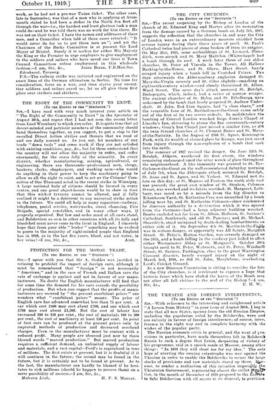THE CITY CHURCHES.
[To me EDITOR 07 THE " SPECTATOR."I SIR,—The recent reopening by the Bishop of London of the church of St. Edmund King and Martyr after its restoration from the damage caused by a German bomb on July 7th, 1917, suggests the reflection that the churches in and near the City of London were in an extraordinary measure shielded from serious injury during their three years of peril. St. Paul's Cathedral twice had pieces, of stone broken off from its exterior. On May 31st, 1915, some outbuildings of St. Leonard, Shore- ditch, were struck and St. Mary 3latfelon (Whitechapel) had a bomb through its roof. A week later three of our oldest churches, St. Peter ad Vincula in the Tower, All Hallows Barking-by-the-Tower, and St. Olave, Hart Street, barely escaped injury when a bomb fell in Crutched Friars. Two days afterwards the Aldermanbury explosion damaged St. Mary-the-Virgin severely and St. Giles slightly—smasbing an eighteenth-century window—and closely threatened St. Alban. Wood Street. The same day's attack menaced St. Botolph, Bishopsgate, which, indeed, had a series of narrow escapes. The ancient churches of St. Helen and St. Ethelburga 'sere unharmed by the bomb that freely peppered St. Andrew Under- shaft. St. John, Red Lion Square, had "a close shave," and the venerable fane of St. Bartholomew-the-Great came safely out of the first of its two severe ordeals. In mid-October the bombing of Central London wrecked Inigo Jones's Chapel at Lincoln's Inn, shivering to atoms the fine seventeenth-century windows; Gray's Inn Chapel just missed a similar fate, as dill the twin Strand churches of St. Clement Danes and St. Mary- of-the-Nativity. In the August of 1916 St. Agnes, Kennington Park, with its wealth of stained glass by Kempe, was just saved from injury through the non-explosion of a bomb that sank into the earth.
The summer of 1917 revived the danger. On June 13th St. Botolpli, Aidgate, weathered its first storm, the windows remaining undamaged amid the utter wreck of glass throughout the neighbourhood. A like immunity was granted to St. Bar- tholomew-the-Great on the well-remembered Saturday morning of July 7th, when the Aldersgate attack menaced St. Botolpls St. Anne and St. Agnes, and St. Vedast. St. Edmund met its fate on this day; at St. Magnus ad Pontem the south aisle roof was pierced; the great east window of St. Stephen, Coleman Street, was wrecked and its fabric scarified; St. Margaret, Loth- bury, was saved as by a miracle from the big disaster in Tokenhouse Yard; St. Katherine Cree was unscathed by a bomb falling near by, and St. Katherine Coleman—since condemned by diocesan authority to a destruction which it was spared from the Germans—had a large adjacent building wrecked. Bombe exploded not far from St. Alban, Holborn, St. Saviour's Cathedral, Southwark, and old St. Pancras; and St. Michael, Shoreditch, stood uninjured by death-dealing bombardments on either side of it. On September 4th St. 'Martin-in-the-Field was in serious danger, as apparently was All Saints, Mar,g(ireb Street. St. Peter's, Hatton Garden, was severely damaged on the 24th, and a bomb falling in-the roadway just failed to affect either Westminster Abbey or St. !Margaret e. October 29th brought peril to St. Peter, Walworth, and St. Peter, Windmill Street; St. Saviour, Paddington, close to the great Warrington Crescent disaster, barely escaped injury on the night of March 3rd, 1918, as did St. John, Ma rylebone, overlooking Lord's Cricket Ground.
As a new Diocesan Commission is sitting to consider the fate of the City churches, is it irrelevant to express a hope that historic fanes which have eluded the havoc of the Bomb tuns not after all fall victims to the zeal of the Bishop P-1 am,


































 Previous page
Previous page